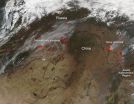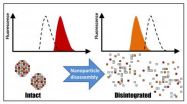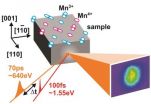(Press-News.org) Forget everything you know about what a loudspeaker should look like. Scientists at Disney Research, Pittsburgh have developed methods using a 3D printer to produce electrostatic loudspeakers that can take the shape of anything, from a rubber ducky to an abstract spiral.
The simple speakers require little assembly, but even those few manual steps might be eliminated in the future, said Yoshio Ishiguro, a Disney Research, Pittsburgh post-doctoral associate. "In five to 10 years, a 3D printer capable of using conductive materials could create the entire piece," he predicted.
The method developed by Ishiguro and Ivan Poupyrev, a former Disney Research, Pittsburgh principal research scientist, will be presented April 29 at the Conference on Human Factors in Computing Systems (CHI) in Toronto.
The speaker technology could be used to add sound to any number of toys or other objects. Because the same speakers that produce audible sound also can produce inaudible ultrasound, the objects can be identified and tracked so that they can be integrated into games and other interactive systems. The objects can be touched or held in a user's hand without a noticeable decrease in sound quality, so simple tactile feedback may also be possible.
The speakers are based on electrostatic speaker technology that was first explored in the early 1930s, but never widely adopted. This type of speaker is simpler than conventional electromagnetic speakers and includes no moving parts, which makes it suitable for producing with a 3D printer.
An electrostatic speaker consists of a thin, conductive diaphragm and an electrode plate, separated by a layer of air. An audio signal is amplified to high voltage and applied to the electrode; as the electrode charges, an electrostatic force develops between it and the diaphragm, causing the diaphragm to deform and produce sound as the audio signal changes.
This type of speaker has relatively little bass response, but does a good job of producing high-frequency sounds, such as chirping birds, computer-generated blips and even the human voice. Sound reproduction of up to 60 decibels is possible – an appropriate level for small objects.
"What's more, it can generate sound across the entire face of the speaker," Ishiguro noted. That makes it possible to not only produce directional, cone-shaped speakers but also omnidirectional speakers in which the entire 3D surface emits sound.
Also, the speakers can be built with any number or configuration of electrodes; placing multiple electrodes in a curved speaker, for instance, makes it possible to vary the direction of the sound emitted.
Ishiguro and Poupyrev created conductive surfaces by spraying a nickel-based conductive paint and developed a method for making full-body compliant diaphragms using negative molds produced by 3D printing and spraying them with the conductive paint and with a polyethylene coating. Once multi-material 3D printers are developed that can print functional electrical circuits and electrodes, these manual steps could be eliminated.
INFORMATION:
More information about 3D-printed interactive speakers, including a video, is available on the project web site at http://www.disneyresearch.com/project/printed-speakers/
About Disney Research
Disney Research is a network of research laboratories supporting The Walt Disney Company. It's purpose is to pursue scientific and technological innovation to advance the company's broad media and entertainment efforts. Disney Research is managed by an internal Disney Research Council co-chaired by Disney-Pixar's Ed Catmull and Walt Disney Imagineering's Bruce Vaughn, and including the Directors of the individual labs. It has facilities in Los Angeles, San Francisco, Pittsburgh, Boston and Zürich. Research topics include computer graphics, video processing, computer vision, robotics, radio and antennas, wireless communications, human-computer interaction, displays, data mining, machine learning and behavioral sciences.
Disney Researchers use 3-D printing to produce interactive speakers of any shape
If it looks like a duck and sounds like a duck, it just might be a loudspeaker
2014-04-28
ELSE PRESS RELEASES FROM THIS DATE:
Well-informed patients key to accepting gene-based drug dosing
2014-04-28
A new study out of Western University (London, Canada) illustrates the need for a lot more education around pharmacogenetics (PGx) –the study of how a patient's genes can affect drug reaction and dosage. PGx promises to optimize patient response to therapy, but this is the first study to really investigate how patients perceive this kind of genetic testing, and whether those perceptions differ when it comes to parents and their children. The research, led by Dr. Michael Rieder of Western's Schulich School of Medicine & Dentistry is published in the journal Pediatrics.
"Pharmacogenetic ...
The thin-crusted US Sierra Nevada Mountains: Where did the Earth go?
2014-04-28
Boulder, Colo., USA – In an addition to Geosphere's ongoing themed issue series, "Geodynamics and Consequences of Lithospheric Removal in the Sierra Nevada, California," Craig H. Jones of the University of Colorado Boulder and colleagues examine the seismological study of the entire extent of the U.S. Sierra Nevada range using seismograms collected in the Sierra Nevada EarthScope field experiment from 2005 to 2007.
The southern Sierra Nevada is known to have unusually thin crust for mountains with such high elevations (peaks higher than 4 km/14,000 ft, and average elevations ...
Precise brain mapping can improve response to deep brain stimulation in depression
2014-04-28
Experimental studies have shown that deep brain stimulation (DBS) within the subcallosal cingulate (SCC) white matter of the brain is an effective treatment for many patients with treatment-resistant depression. Response rates are between 41 percent and 64 percent across published studies to date.
One of the proposed mechanisms of action is the modulation of a network of brain regions connected to the SCC. Identifying the critical connections within this network for successful antidepressant response is an important next step.
A new study using MRI analysis of the ...
Wildfire outbreak in far eastern Russia
2014-04-28
According to the Voice of Russia, "As of Saturday morning, in Russia continue 103 wildfires at 27,412 hectares, including big 26 wildfires in the Far East and in Siberia. On Friday, 147 new fires began at 12,509 hectares, and 150 were extinguished at 5,437 hectares. Emergency situation has been introduced in the regions with most complicated situations - in the Amur region, in the Maritime and Baikal territories. This was according to the EMERCOM's (Emergency Control Ministry) spokesperson Alexander Drobyshevsky.
Satellites (such as Aqua and Terra) have located "1,587 ...
Cyberspace scholarship nets higher grades, better thinking for class Facebook group
2014-04-28
University students who used a Facebook group as part of a large sociology class did better on course assignments and felt a stronger sense of belonging, according to a Baylor University study.
The study has implications for the challenge of teaching large classes, a growing concern for higher education. Classes numbering hundreds of students — particularly in introductory courses — have become common at many universities, said researchers Kevin Dougherty, Ph.D., associate professor of sociology in Baylor's College of Arts and Sciences, and Brita Andercheck, a doctoral ...
Newborn Tropical Storm Tapah threatens Saipan and Tinian
2014-04-28
A tropical storm warning is in force for Saipan and Tinian as Tropical Storm Tapah moves north through the Northwestern Pacific Ocean on April 28. When NASA-NOAA's Suomi NPP satellite passed overhead and, imagery revealed a developing eye in Tapah.
In addition to the tropical storm warning, a typhoon watch is in effect for Alamagan and Pagan as Tapah is expected to continue in a generally northerly direction over the next couple of days. A typhoon watch means typhoon force winds of 74 mph or greater are possible within 48 hours. A tropical storm warning means tropical ...
Fluorescent-based tool reveals how medical nanoparticles biodegrade in real time
2014-04-28
Nanoparticles have been heralded as a potential "disruptive technology" in biomedicine, a versatile platform that could supplant conventional technologies, both as drug delivery vehicles and diagnostic tools.
First, however, researchers must demonstrate the properly timed disintegration of these extremely small structures, a process essential for their performance and their ability to be safely cleared out of a patient's body after their job is done. A new study presents a unique method to directly measure nanoparticle degradation in real time within biological environments.
"Nanoparticles ...
A glassy look for manganites
2014-04-28
Manganites – compounds of manganese oxides - show great promise as "go-to" materials for future electronic devices because of their ability to instantly switch from an electrical insulator to a conductor under a wide variety of external stimuli, including magnetic fields, photo-excitations and vibrational excitations. This ultrafast switching arises from the many different ways in which the electrons and electron-spins in a manganite may organize or re-organize in response to such external stimuli. Understanding the physics behind these responses is crucial for the future ...
Ozone levels drop 20 percent with switch from ethanol to gasoline
2014-04-28
A Northwestern University study by an economist and a chemist reports that when fuel prices drove residents of São Paulo, Brazil, to mostly switch from ethanol to gasoline in their flexible-fuel vehicles, local ozone levels dropped 20 percent. At the same time, nitric oxide and carbon monoxide concentrations tended to go up.
The four-year study is the first real-world trial looking at the effects of human behavior at the pump on urban air pollution. This empirical analysis of atmospheric pollutants, traffic congestion, consumer choice of fuel and meteorological conditions ...
Risk of cesarean delivery 12 percent lower with labor induction
2014-04-28
The risk of a cesarean delivery was 12% lower in women whose labour was induced compared with women who were managed with a "wait-and-see" approach (expectant management), according to a research paper published in CMAJ (Canadian Medical Association Journal).
Labour is induced in about 20% of all births for a variety of reasons such as preeclampsia, diabetes, preterm rupture of the membranes, overdue pregnancy and fetal distress. Induction is often thought to be associated with increased risk of cesarean deliveries despite evidence indicating a lower risk. However, much ...
LAST 30 PRESS RELEASES:
Norbert Holtkamp appointed director of Fermi National Accelerator Laboratory
New agentic AI platform accelerates advanced optics design
Biologists discover neurons use physical signals — not electricity — to stabilize communication
Researchers discover that a hormone can access the brain by hitchhiking
University of Oklahoma researcher awarded funding to pursue AI-powered material design
Exploring how the visual system recovers following injury
Support for parents with infants at pediatric check-ups leads to better reading and math skills in elementary school
Kids’ behavioral health is a growing share of family health costs
Day & night: Cancer disrupts the brain’s natural rhythm
COVID-19 vaccination significantly reduces risk to pregnant women and baby
The role of vaccination in maternal and perinatal outcomes associated with COVID-19 in pregnancy
Mayo Clinic smartwatch system helps parents shorten and defuse children's severe tantrums early
Behavioral health spending spikes to 40% of all children’s health expenditures, nearly doubling in a decade
Digital cognitive behavioral treatment for generalized anxiety disorder
Expenditures for pediatric behavioral health care over time and estimated family financial burden
Air conditioning in nursing homes and mortality during extreme heat
The Alps to lose a record number of glaciers in the next decade
What makes a good proton conductor?
New science reporting guide published for journalists in Bulgaria
New international study reveals major survival gaps among children with cancer
New science reporting guide published for journalists in Turkey
Scientists develop a smarter mRNA therapy that knows which cells to target
Neuroanatomy-informed brain–machine hybrid intelligence for robust acoustic target detection
Eight SwRI hydrogen projects funded by ENERGYWERX
The Lundquist Institute and its start-up company Vitalex Biosciences Announces Strategic Advancement of Second-Generation fungal Vaccine VXV-01 through Phase 1 Trials under $40 Million Competitive Con
Fine particles in pollution are associated with early signs of autoimmune disease
Review article | Towards a Global Ground-Based Earth Observatory (GGBEO): Leveraging existing systems and networks
Penn and UMich create world’s smallest programmable, autonomous robots
Cleveland researchers launch first major study to address ‘hidden performance killer’ in athletes
To connect across politics, try saying what you oppose
[Press-News.org] Disney Researchers use 3-D printing to produce interactive speakers of any shapeIf it looks like a duck and sounds like a duck, it just might be a loudspeaker





